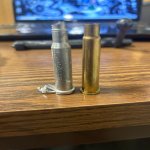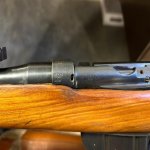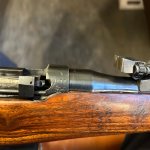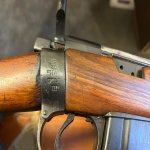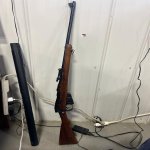This is a little outside my wheelhouse so please bear with my ignorance.
Bought a Sht. Lee III* sporter, and it won't chamber .303 British factory ammo. Cartridge comes to a sudden and sharp stop about 3mm from where it needs to for the bolt to go into battery. There are no visible obstructions, I've tried it with no magazine in the rifle and with an empty cartridge, as well as an empty cartridge that I trimmed back about 2mm - same story. It chambers a loaded .308 Win round easily, but I have not attempted to fire that
Google has told me that people have rechambered some of these to something called ".303 Sporting" for legal reasons (not allowed to own a military-cartridge-firing firearm?)which basically involved bumping the shoulder down and trimming off 2mm or so. That would, I think, jive with what I'm seeing here but I can find no barrel markings that translate to a rechambering job... but I'm no expert on Lee Enfield stamps/markings. Also I know that there is such a thing as a .308 Win conversion that has been done in the past, but it should include a modified or maybe a completely different magazine - my rifle has a standard SMLE mag as far as I can tell. .308 definitely doesn't feed out of it.
Any thoughts, ideas, ways to tell what it's chambered in or whether there's something else wrong? I can provide photos of all it's markings and even borescope images if that would help.
Thanks
Bought a Sht. Lee III* sporter, and it won't chamber .303 British factory ammo. Cartridge comes to a sudden and sharp stop about 3mm from where it needs to for the bolt to go into battery. There are no visible obstructions, I've tried it with no magazine in the rifle and with an empty cartridge, as well as an empty cartridge that I trimmed back about 2mm - same story. It chambers a loaded .308 Win round easily, but I have not attempted to fire that
Google has told me that people have rechambered some of these to something called ".303 Sporting" for legal reasons (not allowed to own a military-cartridge-firing firearm?)which basically involved bumping the shoulder down and trimming off 2mm or so. That would, I think, jive with what I'm seeing here but I can find no barrel markings that translate to a rechambering job... but I'm no expert on Lee Enfield stamps/markings. Also I know that there is such a thing as a .308 Win conversion that has been done in the past, but it should include a modified or maybe a completely different magazine - my rifle has a standard SMLE mag as far as I can tell. .308 definitely doesn't feed out of it.
Any thoughts, ideas, ways to tell what it's chambered in or whether there's something else wrong? I can provide photos of all it's markings and even borescope images if that would help.
Thanks
Last edited:















































